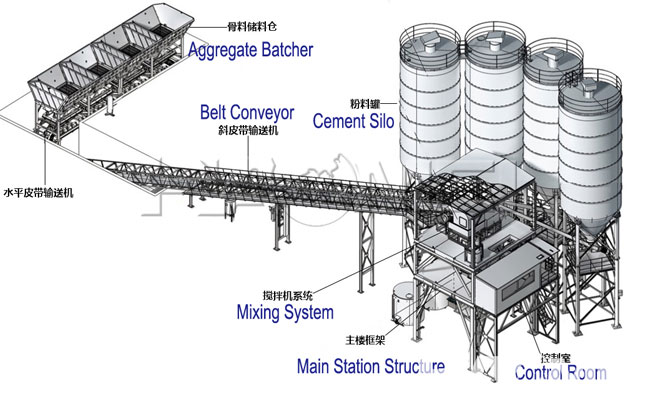Components of RMC Plant
Writer:Admin Time:25/02/13In the booming construction industry, ready mix concrete plant plays a crucial role, its efficient production of ready mix concrete lays a solid foundation for all kinds of construction projects. To understand its working principle and operation mechanism, you need to understand the components of rmc plant equipment.
The components of rmc plant including 5 parts, material storage system, material conveying system, material measuring system, mixing system and control system.
1. Material Storage System
The material storage system is the “warehouse” of the rmc plant, which is mainly used for storing all kinds of raw materials required for the production of concrete. Cement silo is an important container for storing cement, and it usually adopts steel structure, which can effectively prevent moisture and agglomeration and ensure stable quality of cement. Fly ash silo has a similar role, specifically for the storage of fly ash, this industrial waste in the concrete can play a role in improving performance and reducing costs. In addition, there are silos for storing sand, gravel and other aggregates, according to the type of aggregate and different particle sizes, will set up a number of independent silos to meet the production needs of different compatibility ratios.

2. Material conveying system
The material conveying system is like the “blood vessel” of the ready mix concrete batching plant, responsible for accurately conveying the stored materials to the designated location. Screw conveyor is the commonly used equipment for conveying cement and fly ash, which conveys the materials smoothly along the pipeline through the rotation of screw blades. Belt conveyor, on the other hand, is mainly used for conveying sand and gravel aggregate, which has the advantages of large conveying capacity, long conveying distance, stable operation, etc., and is able to quickly convey the aggregate from the silo to the mixing host.
3. Material Measuring System
The material measuring system is the “accurate scale” of the ready mix concrete plant, which is directly related to the quality of concrete. It includes aggregate metering scale, cement metering scale, fly ash metering scale, water metering scale and admixture metering scale. With high-precision sensors, these metering scales are able to accurately measure the weight of each material and batch it according to a preset mix ratio. The advanced measuring system can control the error within a very small range, ensuring that each batch of concrete produced has stable performance.
4. Mixing system
The mixing system is the “heart” of the RMC plant, which is mainly composed of the mixing host and mixing device. There are various types of mixing hosts, the common ones are forced mixer and self-falling mixer, the former has high mixing efficiency and good mixing quality, which is suitable for various types of concrete production and is widely used. The mixing device, through the high-speed rotation of the mixing blades, mixes the measured materials well, so that the concrete reaches an ideal mixing state between the components.
5. Control System
The control system is the “brain” of the mixing plant, through which the operator monitors and manages the operation of the whole concrete mixing plant. The control system is not only able to realize the automatic operation of material conveying, measuring, mixing and other aspects, but also real-time monitoring of the operating status of the equipment, fault alarms, and recording and storing the production data, which is convenient for subsequent quality tracing and production analysis.
The various components of rmc plant equipment cooperate with each other and work closely together to ensure efficient and stable concrete production. Understanding these components is important for optimizing the operation of the concrete mixing plant and improving the quality of concrete.
- Previous:Ready Mix Plant: Innovative In Construction Industry...
- Next:Commercial Concrete Mixing Plant...

